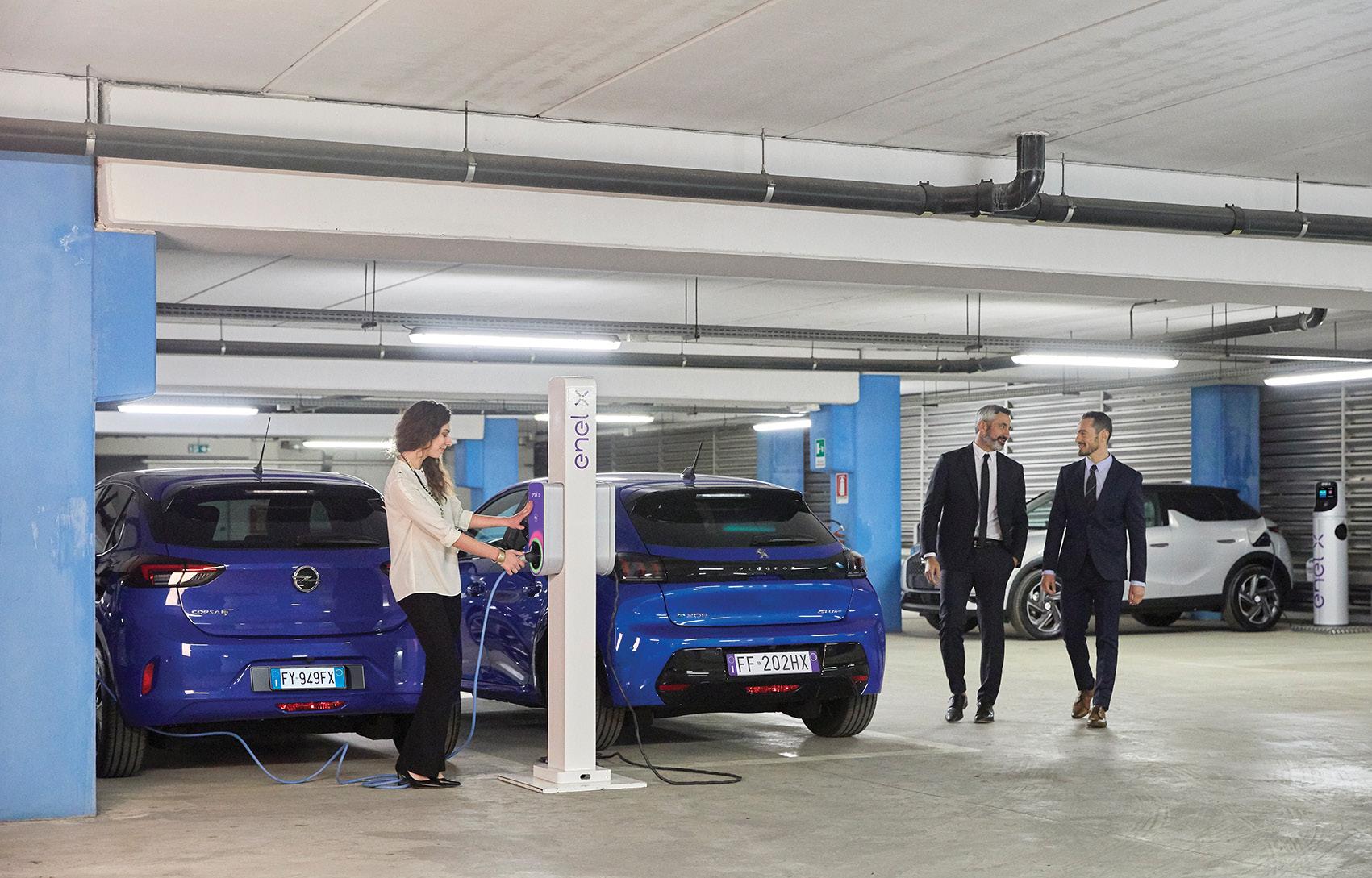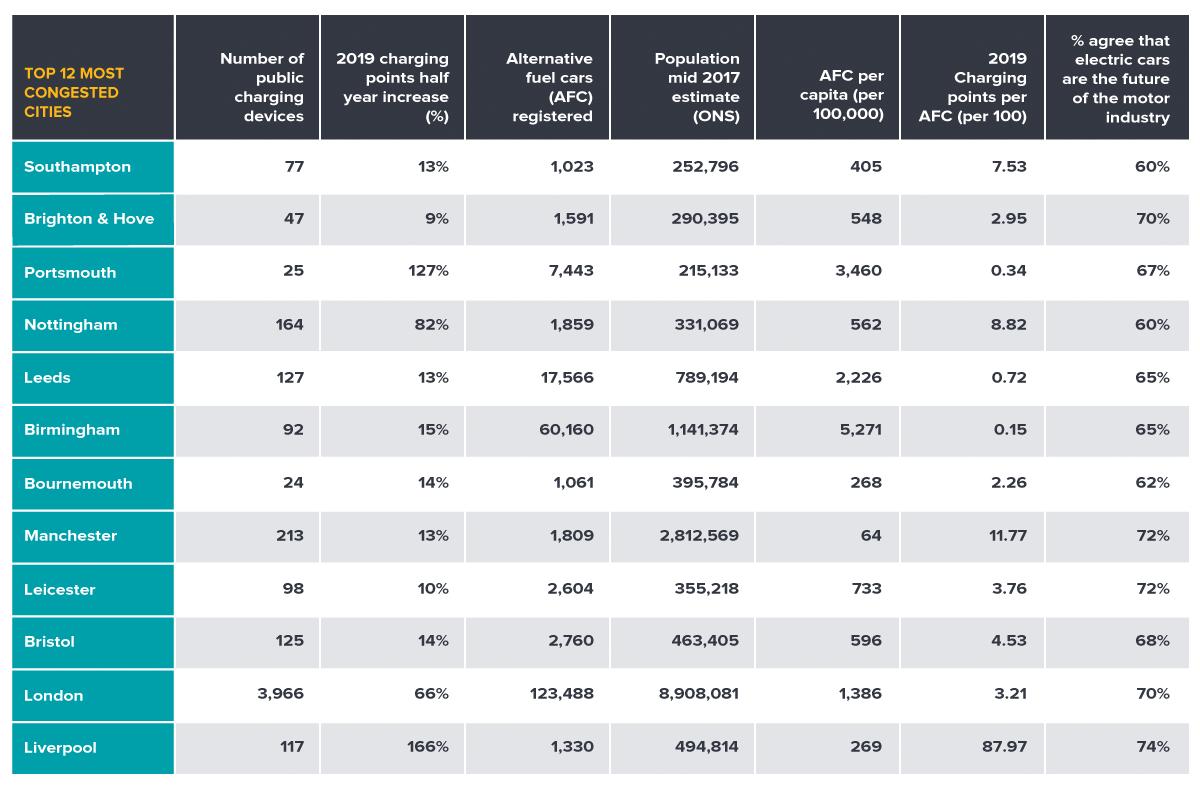
12 minute read
Driving the Future
Conceptually, charging an electric vehicle is a simple task. In reality, providing the infrastructure to support e-mobility is giving energy managers a lot to think about. However, with the right approach, businesses can optimise their investment in charging infrastructure so that it works for them and their end users. THE BUSINESS AND LEGISLATIVE DRIVERS
Transport accounts for around a quarter of global emissions. Consequently, many businesses are looking to lead on climate change action by decarbonising their vehicle fleets and boosting EV use by providing workplace charging.
The UK has passed legislation to ban sales of new petrol and diesel vehicles by 2035 at the latest, and is simultaneously looking to accelerate the EV market by providing attractive tax-breaks to business users. Meanwhile, some businesses are looking to lead on zero-emission transport as a tangible demonstration of their commitment to combat climate change. For delivery firms and logistics companies where transport is the core of the business, those who can offer a net-zero service first will attract new customers.
This potent combination of government legislation, financial incentives and user demand is compelling businesses to act on EV charging. For businesses looking to invest in onpremise EV charging, it’s important that they consider the big-picture view of their energy needs first, and consider both operational and procurement issues before rushing into projects.
Some of the key issues include: site capacity and load; choosing the right charger; taking a modular approach to design; identifying grid balancing opportunities and signing up to the right supply contract. SITE CAPACITY AND LOAD
For many sites, considering the impact of adding EV charging stations on site power load is fundamental to the feasibility and cost of the project. While a basic parking facility might have a power load of just 5-10kW for features like lighting and barrier entry, adding a single rapid charging unit will increase the peak power load for that facility by 5-10x. Providing workplace charging for EV fleets introduces a key challenge – how to manage overall power loads at facilities.
Large sites with half-hourly billing will have agreed a maximum import capacity (MIC) with their supplier. Capacity needs to be in line with demand, and exceeding the MIC incurs financial penalties. There may also be a risk of exceeding total supply capacity by using EV charging stations while operating normal electrical loads in buildings.
The Distribution Network Operator will be involved in looking at worst-case power load scenarios to assess whether network upgrades are required, which can take many weeks and require significant investment if the business has to pay to reinforce the network. The extent to which the customer has to pay for these connection costs is under review as part of the Access and Forward Looking Charges Review, and could be more onerous in future.
By monitoring the building’s energy consumption, the charging process can be remotely managed in real-time while making the most of the existing available power. This approach can avoid the need for expensive network reinforcement, enabling optimal use of charging infrastructure while minimising costs through dynamic load balancing.
FUTURE-PROOFING EV INFRASTRUCTURE
Andrew Toher, Head of Customer Insights Enel X UK
SPECIFYING CHARGERS
Rather than taking a one-size-fits-all approach, it is necessary to consider the needs of users and the potential business models when specifying charging solutions for public and private infrastructure. For example, a 50kW fast charger may be too fast for a shopping centre or a business park, where visitors are expected to stay on-site for a number of hours.
A retail park, pub or motorway service station will have different business requirements that are met by different charging solutions. Some operators of public charging infrastructure earn revenue by renting parking spaces from the site owners for a fixed annual fee, while the site owner benefits from an additional customer amenity and, in some cases, a share of the charging revenue. Optimising revenue and return on investment requires careful choice of the charging solution to offer, i.e. the right charging solution for the right setting to achieve best customer experience and best return on investment. MODULAR PLANNING
Balancing the needs of users with a design that satisifies those needs will be challenging for any business committing to providing EV infrastructure for employees. There are many variables at play, including the rate of uptake of e-mobility, EV battery range, technology advances and how drivers choose to charge their cars; whether keeping them ‘topped up’ or recharging from empty.
Taking a modular approach to specifying on-premises EV charging reduces investment risk. By planning for future expansion while implementing what’s needed today, businesses can review usage patterns and power loads and base their decisions about future needs on real data. SUPPLY CONTRACTS
Another consideration for businesses is whether they are signed up to the most appropriate supply for EV charging. Some energy suppliers are introducing innovative tariffs that are highly suited to smart EV charging. However, it may
become more difficult to realise benefits from off-peak time-of-use tariffs as EV charging becomes the norm.
Beyond simply agreeing to a bespoke tariff for energy use, businesses can also choose how their power is generated; use of ‘green’ tariffs; the pricing/ payment/billing model; financing for the new assets; onsite/offsite generation; resilience measures; the use of energy management technology and their own distributed assets for generation, demand response or energy storage. GRID BALANCING
Whether businesses can usefully use their EV fleets as energy storage assets or virtual power plants to help balance the grid is still some way off. Using EVs for energy storage requires vehicle-to


grid (V2G) technology and the ability to discharge the car’s battery to the grid. Despite successful proof-of-concept V2G trials, there are some practical barriers to implementing V2G today, foremost of which is limited EV manufacturer support for bidirectional charging. PLANNING FOR THE FUTURE
Workplace EV charging infrastructure will become prevalent in the coming years, as businesses look to enable e-mobility. By taking a holistic view of energy use and planning for the future, businesses can embrace zero-emission transport without later regretting investment decisions they might make today. www.enelx.com
CHARGING AHEAD ON THE ROAD TO ZERO EMISSIONS Richard Baker, CEO of GeoSpock
The UK transport sector contributes more to carbon emissions than any other. It’s therefore no surprise that the government is encouraging more people to switch to electric vehicles (EVs) In February, the UK government brought forward their ban on new petrol, diesel or hybrid cars from 2040 to 2035, paving the way for greater adoption of hybrids and EVs that run on cleaner energy.
However, it is not that simple – the EV transition strategy lacks a few crucial pieces.
Deloitte has estimated that the global EV market will reach a tipping point by 2022, when the cost of ownership of an electric vehicle will be on par with the internal combustion engine (ICE). Unfortunately, it could also result in a supply gap of almost 14 million EVs in 2030, undermining government efforts.
The aim is clear – moving toward the electrification of the private and public road transport sectors. However, there’s still a long way to go and many things to consider. COMPLEXITIES OF A NATIONAL CHARGING INFRASTRUCTURE
In January 2020, a new Ipsos Global study revealed that consumers ranked the location and availability of charging stations as one of the biggest barriers to EV adoption. To address this, the Conservative government made a £500 million election commitment to expand the ‘fast-charging network’. This could lead to a substantial

improvement from the 15,500 chargers / 26,500 plugs which are present, according to Zapmap. However, compare that to the 8,400 fuel stations and 68,000 pumps currently in the UK, and we have a better understanding of the current situation.
If we accept that the number of charging stations has to increase, and that the government is reacting, we must consider their location. Choosing the best sites are complex due to competing factors such as local grid constraints and EV ownership density. Unlike traditional refilling at petrol stations, it’s not a one-size-fits-all system. The type of charge point best suited to each location will depend on the profile of each area and the driving habits of EV users within it.
The wide range of charging speeds, and potentially long recharge times, means EV charging infrastructure needs to fit alongside existing driving behaviours and activities. If, for example, the majority of EV drivers prefer to charge up their vehicles while they do Saturday’s shopping in a particular district, then that is vital data for charge point locations. CHARGE POINTS AS DATA GOLDMINES
Operational data on charging – such as time of day, charge duration, the amount of power delivered and what type of connector was used – is now collected in conjunction with commercial data related to payment methods and transaction amounts. In addition, modern EVs are far more digitally enabled than traditional vehicles, constantly recording high volumes of additional spatial data during the day.
Taking into account all the different variables makes it a delicate balancing act to decide what the demands are for drivers – whether visiting any given neighbourhood supermarket or central business district car park now, or in the future. That’s where the power of geospatial data will help. This can highlight unique usage patterns in specific areas and shed light on which is the best route to take when it comes to EV infrastructure investment. Once you have a clear picture of charging use and behaviour in a particular location, you can remove a lot of the guesswork from charging infrastructure decisions. THE “OVERPOWERED” ELEPHANT IN THE ROOM
We are in the energy age – every nation is looking to fill the void left by fossil fuels and make efficient, futureproof decisions. As EVs become more widespread, electrical demand will grow and, on current estimations, outstrip the capacity of local power grids. This in turn will force EV charging networks to compete with each other in infrastructure projects for electricity.
There is also concern over electrifying public transport. UK buses and trains are due a complete overhaul, purely from an efficiency standpoint. Factor in electrification, and the public transport network needs huge and ongoing investment if it is to meet modern and future demands.
The UK government has set bold and welcome plans for EVs. It is the first step in making the UK transport industry fit for purpose. However, simply banning or phasing out old, inefficient vehicles and expecting private companies to develop new technology to fill the void will not suffice.
We need to make decisions that will benefit us, not just for the here and now, but for the unforeseeable future. Building charging points is to be lauded, but what happens if the technology is made redundant, or if public habits change? Instead, the government must look to invest in data, creating a holistic transport hub to understand activity and trends in the industry. Only then can we make informed, real-time decisions and ensure the national move to electrification is moving forward in the most efficient and flexible way possible. https://geospock.com/en
As the government announced that they will be bringing forward the plan to ban the sale of conventionally powered vehicles by 2035, new research has revealed the UK could hit its target of ‘most vehicles on the road being low emission’, as early as 2034, however, Brits have major concerns about making the switch.
The research from leading car parts retailer, Euro Car Parts, looked at the UK as a whole, as well as drilling down into the capital and also the UK’s 10 most congested cities outside of London, to see how prepared they are to make the switch.
Based on calculations that consider factors such as the population, the amount of public charging points and their increase rate since January 2019, as well as the volume of alternative fuel cars currently registered, the research revealed Southampton will be ready for the electric takeover the quickest1.
The southern city currently has 77 charging points, a 13% increase since January, alongside a relatively low population compared to other major cities and 1,023 alternative fuel cars registered.
London has seen a 66% increase in charging points since the start of the year to almost 4,000, however due to its vast population (9m) and number of electric vehicles already on the road (123k), it still has a long way to go to be completely ready for the electric takeover.
Here are the UK’s most congested cities in order of how ready they are for the electric takeover:
Looking at the UK as a whole, a Department for Transport report in 2018 stated only 2% of registered vehicles were low emission. And while this seems a long way off target, the YoY growth2 shows the UK has had a 37% increase in low emission cars since 2016. If it continues at this rate, the UK will have 38.2m low emission vehicles on the road by 2034, leaving the government hitting its target an impressive 16 years before its 2050 deadline.
Despite the target already predicted to be hit earlier than anticipated, Euro Car Parts’ research revealed the nation’s drivers aren’t quite ready to take the plunge.
The research with 2,000 UK drivers highlighted ‘not enough charging points’ and ‘being stranded without charge or accessibility to charging services’, were their main concerns (66%), and according to YouGov3, only 4% would consider purchasing an electric car as their next vehicle.
Looking further into the volume of charging points, the UK has seen an average of 28% increase in charging points being installed YoY since 20164. If this rate continues, the UK is expected to have 322 public charging points per 10,000 low emission vehicles by 2034, suggesting the UK’s roads won’t be fully equipped for the transition, and may not meet day-to-day demand.
The number of charging points weren’t the only concern, with the distance-per-charge a worry for half of motorists (47%), as well as their electricity bills increasing (27%) and it actually being more costly than owning a petrol/diesel vehicle (22%).
Commenting on the findings, Chris Barella, Digital Services Director at Euro Car Parts, says: “It’s interesting to see that while figures suggest the government are on track to hit their low emission vehicle target, perhaps even earlier than anticipated, the nation’s views and attitudes towards alternative fuel vehicles, means we still have a long way to go.
“It seems the biggest concern is the number of charging points and it’s understandable why. If the YoY figures are anything to go by, we simply won’t be equipped to supply the demand, however it’s encouraging the government is increasing its funding for charging points in residential areas. Hopefully seeing more around the country will inspire the nation’s drivers to make the switch and help us to achieve the initiative as early as predicted.”
For more information on how prepared the UK’s major cities are for the electric takeover, please visit: https://www.eurocarparts.com/ blog/the-uk-cities-most-preparedfor-the-electric-car-takeover THESE ARE THE CITIES MOST PREPARED FOR THE ELECTRIC CAR TAKEOVER • The Government announced plans to ban the sale of conventional vehicles by 2035, Brits remain dubious about switching to electric cars • Study reveals how well UK cities were prepared as of 2019











